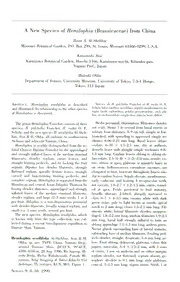
A new species of Hemilophia (Brassicaceae) from China PDF
Preview A new species of Hemilophia (Brassicaceae) from China
A New Species of Hemilophia (Brassicaceae) from China Ihsan A. Al-Shehbaz Missouri Botanical Garden, P.O. Box 209, St. Louis, Missouri 63166-0299, U.S.A. Katsutoshi Arai Karuizawa Botanical Garden, Hocchi 1166, Karuizawa-machi, Kitasaku-gun, Nagano Pref., Japan Hideaki Ohba Department of Botany, University Museum, University of Tokyo, 7-3-1 Hongo, Tokyo, 113 Japan Abstract. Hemilophia sessilifolia is described Species ab //. pulchella Franchet et //. rockii (). E. and illustrated. Its relationship to the other species Schulz foliis caulinis sessilibus, sepalis membranaceis in- tegris (acile cadentibus, petalis persistentibus, stylo gla- of Hemilophia is discussed. bro. et trichomatibus simplicibus obtecta bene differt. The genus Hemilophia Franchet consists of three Herbs perennial, rhizomatous. Rhizomes slender, species, //. pulchella Franchet, //. rockii 0. E. not scaly. Stems 1 to several from basal rosette or Schulz, and the new species //. sessilifolia Al-Sheh- solitary from rhizomes, 3—9 cm tall, simple or few- haz, Arai & H. Ohba, all endemic to southwestern branched, with spreading to appressed simple tri- Sichuan and adjacent Yunnan, China. chomes 0.06—0.25 mm long. Basal leaves oblan- Hemilophia is readily distinguished from the re¬ ceolate, 6—10 X 1.5—2.5 mm, dry at anthesis, lated Chinese Dipoma Franchet by the appendaged densely beset with straight simple trichomes 0.8- and strongly inflated bases of the median staminal 1.3 mm long. Cauline leaves oblong to oblong-ob- filaments, slender replum, entire leaves, and lanceolate, 2.5—5(—8) X l-2(—2.5) mm, sessile, en¬ straight fruiting pedicels, and by lacking the fruit tire, obtuse at apex, glabrous or minutely Hairy as septum. Dipoma lias slender filaments, strongly on stem. Inflorescences corymbose racemes, not flattened replum, apically dentate leaves, strongly elongated in fruit, bracteate throughout; bracts sim¬ curved and loop-forming fruiting pedicels, and ilar to cauline leaves. Sepals obovate, membranous, complete septum. Hemilophia is separated from the early caducous and leaving 4 receptaeular teeth, Himalayan and central Asian Dilophia Thomson by not saccate, 1.8—2.7 X 1.2—1.5 mm, entire, round¬ having slender rhizomes, appendaged and strongly ed at apex. Petals persistent to fruit maturity, inflated bases of the median staminal filaments, broadly obovate, 2-lobed, abruptly narrowed to slender replum, and large (2-3 mm) seeds, I or 2 claw, 6—7 X 4—5.5 mm, creamy white with dark per fruit. Dilophia is a non-rhizomatous perennial green veins, pale to light brown at mouth, apical with slender filaments, broadly winged replum, and notch to 2 mm deep; claws 1.5—2.5 mm long. Fil¬ small (ca. 1 mm) seeds, several per fruit. aments white; lateral filaments slender, unappen- The new species, Hemilophia sessilifolia, which daged, 1.8-2.2 mm long; median filaments 1.9-2.5 is known only from the type collection, was col¬ mm long, basal Half strongly inflated to form an lected during a recent Sino-Japanese expedition to oblong appendage 1.1—1.3 mm long; anthers green. Dauxue Shan, Yunnan. Nectar glands surrounding base of lateral stamens, subtending base of median filaments. Fruiting ped¬ lltMiiilopliia sessilifolia Al-Shehbaz, Arai & H. icels slender, straight, divaricate, 5—6 mm long, pi¬ Old ta, sp. nov. TYPE: China. Yunnan: Deqe, lose. Fruit oblong, dehiscent, glabrous; valves thin around Dauxue Shan, 28°34'N, 99°48'E, papery, navicular, 3-4 X 1.5-2 mm, with 3 rows 4300—4550 m, 28 Aug. 1996, Wu Sugong, Hi¬ of crests, 1 row on midvein and on either margin; roshi Ike da, Michio Wakabayashi, Futoshi Mi¬ replum slender, not flattened; septum absent; gy- yamoto, Yang Yongping & Takao Kikuchi 953 nophore obsolete to 0.1 mm long; style glabrous, (holotype, TI; isotypes, KUN, MO). Figure 1. conical, 1—1.5 mm long; stigma entire. Seeds 1 or Novon 9: 8—10. 1999. Volume 9, Number 1 Al-Shehbaz et al. 9 1999 Hemilophia sessilifolia from China Figure 1. Hemilophia sessilifolia Al-Shehbaz, Arai & H. Ohba. —A. Plant. —B. Sepal. —C. Petal. —I). Median filament. —E. Lateral filament. —F. Fruit and persistent petals. —G. Fruit, dorsal view. —H. Fruit after removal of valves and seeds. —I. Seed. Scale bars: A = 1 cm; B-E, G-I = I mm; F — 5 mm. Drawn from the isotype al MO. 10 Novon 2 per fruit, oblong, 2.5—3 X 1.1-1.3 mm, smooth; that remain until fruit develops, caducous petals, a cotyledons obliquely accumbent. minutely papillose cylindric style, and 2-forked tri¬ chomes on the stem. Hemilophia pulchella is sep¬ Hemilophia sessilifolia is readily distinguished arated from //. rockii by having purplish petals 3- from the two other species of the genus, //. pul- 4 mm long instead of white petals 5-7 mm long, chella and H. rockii, by the sessile cauline leaves, stem trichomes with long and straight instead of membranous, readily caducous entire sepals, per¬ short and crisped rays, and an entire instead of sistent petals, glabrous conical style, and exclu¬ ciliate sepal margin. sively simple trichomes. Both //. pulchella and //. Acknowledgment. We thank Neil Harriman for rockii have petiolate cauline leaves, green sepals his review of the manuscript.
